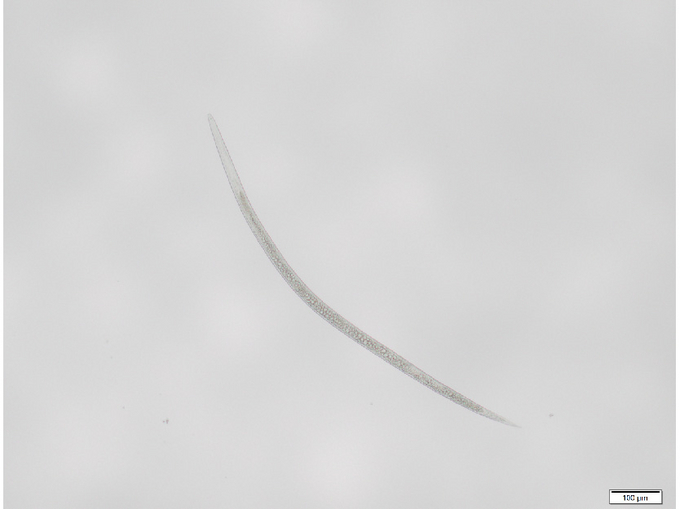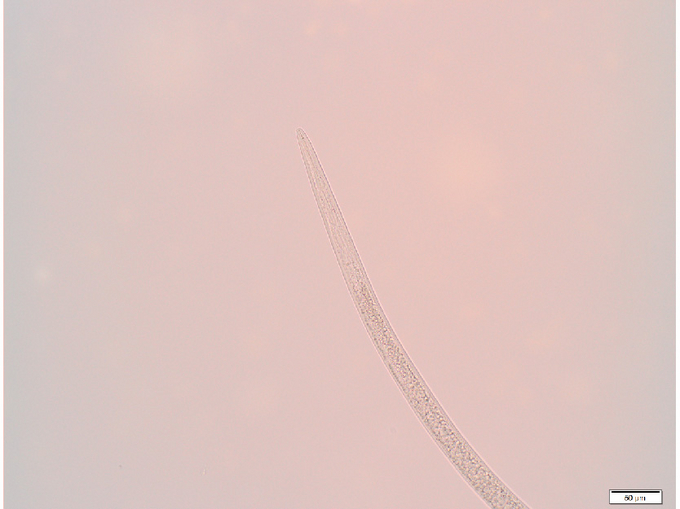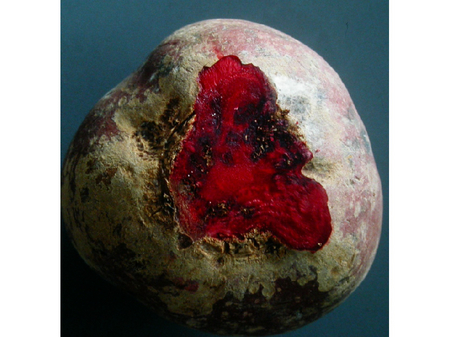Stem and bulb nematode
Ditylenchus dipsaci
Profile
The stem louse Ditylenchus dipsaci is an economically important pest in many field and vegetable crops with a very broad host plant spectrum. It is also of importance in fruit growing on strawberry and in ornamental plant production. It occurs worldwide in temperate climate regions. Symptoms on infested plants are varied. Ditylenchus dipsaci is listed as a Union regulated non-quarantine pest and is transmitted by certain planting material. The presence of such pests results in unacceptable economic consequences with respect to the intended marketing of the planting material. The import and movement within the EU are therefore uniformly regulated for specific seed and planting material.
Appearance
Adult elytra grow up to 1.5 mm long, reaching a diameter of 0.025 mm. They are colorless and transparent. The buttoned mouth spine is delicate and short. The tail end is pointed.


Biology
This nematode species is very well adapted to the lifestyle of its host plant and can complete its development cycle here. The elytra only enter the soil to seek out new host plants. Stem eelworms retain their worm-like shape in both sexes throughout their lives. They possess only longitudinal musculature, so they move in a sinuous manner.
Like all herbivorous nematodes, they have a mouth spine at the anterior end, which is protruded at its posterior end into so-called spiny knobs, to which muscles attach that propel this mouth spine into the host cell. This is done by a rapid series of muscle contractions. The rear end of the spine, which is traversed by a longitudinal channel, merges into the pharyngeal tube, so that pierced plant cells are sucked out as it were with a straw. However, through their mouth sting they release digestive enzymes into their environment, dissolving the middle lamellae between the plant cells. Thus, they are able to squeeze through the cavities created between the cells. Contrary to their name, they colonize not only stems, but also leaves and even seeds.
While they are almost absent in "pure" root systems, they can still be found in various root-like plant parts such as rhizomes, turnips, or tubers. When host plants become exhausted and die, the elytra abandon them. Stem elytra can enter a dry rigidity in the 4th larval stage, in which they are able to survive adverse living conditions for decades. For example, infested plant parts were discovered in a herbarium whose causal agents could still be brought back to life after 23 years.
To colonize a new host plant, the eelworms penetrate the interior of the host through stomata on above-ground plant parts and can now complete their entire development cycle well protected inside. During a life span of 45-73 days, a total of about 200-500 eggs are laid. Egg laying already takes place at low temperatures starting at 5 °C. The optimal development temperature is around 16 °C. The total development period at 15 °C is 19-23 days, so numerous generations can develop in each season.
This nematode species is well adapted to moist, cool climate and is found in our country mainly in heavier soils. In the hot season, the possibility of development is limited, so the most severe damage has been described in the spring and the fall. If damage was once observed in a field, it is likely to continue in the future, as the pest is capable of surviving adverse conditions for a long time.
It has been known for a long time that the stem louse occurs in numerous races, which do not differ in shape, but in the host plants they use. For example, since time immemorial, a beet race, an onion race, a rye race, a field bean race, etc. have been distinguished.
Damage symptoms
A close crop rotation with main host plants and cold wet weather in spring promote infestation of plants with the stem louse. Symptoms on plants in the field show up as foci or nests spread across the field. On the plants themselves, symptoms vary depending on the plant species infested. In general, swelling, thickening may be observed on infested plant parts. Growth retardation, undulations, curling, bending and twisting of leaves and stems, as well as sprouting of lateral buds and excessive tillering in various plant species may occur. Necrosis and rotting of the stem base, bulbs, tubers, or even on rhizomes may also occur during the growing season. Rot of affected bulbs or tubers may be increased during cold storage.
Onions show twisted and deformed stems. The base of the stem is thickened, and the leaves remain small. The onions themselves become soft and begin to rot over time; rotting intensifies during cold storage. In carrots, infestation leads to head rot. In celery, there is sprouting of lateral buds, formation of deformed and deformed stems, cracks in the tuber. Stem rot also promotes secondary infestation with fungal pathogens such as Fusarium.
In sugar beets, superficial white pustules first appear on the beet body in summer, later internal necroses develop in the beet head, these often turn into rot (beet head rot), while the beet appears almost intact externally.



Host plants
The stem louse has about 400 different host plant species and can develop and cause damage on many crops, such as sugar beets and fodder beets, onions, leeks, garlic, chives, rye, corn, clover, alfalfa, celery, carrots, field beans, garden beans, peas, canola, soybeans,... a wide variety of flower bulbs, as well as on numerous wild plants. Among these, deadnettle species, chickweed, knotweed species and burdock weed are particularly good host plants.
Propagation and transmission
The stem lice can actively migrate in the soil from plant to plant in dense vegetation. Passively, they can be spread by adhering soil and plant parts to equipment used in the cultivation of fields (tractor tires, harvesting equipment,...) and to footwear. Natural spread in the soil is very slow and is linked to greater soil moisture.
Prevention and control
- Use of certified seed prevents introduction to previously infestation-free areas
- Avoidance of the introduction of infestation through soiled agricultural machinery, tractor tires, rubber boots, .... by cleaning the machinery in the field
- Infestation areas are to be avoided in the long term when cultivating endangered crops
- Targeted and effective weed control
- If infestation with stem nematodes is detected, the cultivation of host plants should be avoided as far as possible. This applies especially to sugar beets, carrots, celery, peas, field beans, alfalfa, onions. A cultivation break of five years is recommended.
- If infestation with stem nematodes is detected, the cultivation of crops with high stem nematode multiplication such as corn, rye or potatoes should also be avoided. These crops do not show specific symptoms when infested but contribute to high stem nematode proliferation and can then cause economic damage to a subsequently susceptible crop.
- Cultivation of non-host crops such as wheat and barley may be recommended to reduce stem nematodes in the soil for a subsequent susceptible crop.
- Cultivation of catch crops, such as oil radish or various grasses, is favorable.
- Varieties with resistance or tolerance to stem lice are available for some host crops. The designation "resistant" or "tolerant" to D. dipsaci is important.
Last updated: 03.10.2025
automatically translated